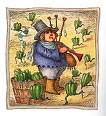|
Jokes, Riddles and Tongue Twisters are created by children usually in game playing, counting, and entertainment. Games are an important aspect of child development, including role identification and socialization. Jokes and riddles especially require intelligence on the part of the child, for both the teller and the listener. Jokes and riddles are often based on wordplay, including words that sound the same but have different meanings (what's black and white and red (read) all over... a newspaper), creation of nonsense words that reflect standard language structure (what do you give a sick pig...oinkment) and other standard types, including knock knock jokes, nonsense/obvious jokes (why did the chicken cross the road), jokes based on wit and paying attention ( Do you say, "Nine and five is thirteen," or "Nine and five are thirteen" ? Neither. Nine and five are fourteen) and rhyming jokes (what do you call a greasy pullet... a slick chick ). Obviously, jokes vary from region to region, and are often based on the children's understanding of the world around them. Therefore, city jokes are likely to vary from rural jokes, and jokes common in the Northwest are likely to be different from those told in the Southeast. Likewise, jokes are a function of era. Clearly, as technology and fashion have changed, so will be jokes concerning those elements. Tongue twisters are a special group that are designed both for entertainment and also to demonstrate the verbal prowess of the speaker. Generally, tongue twisters are appreciated by a specific group of children who find the balance between vowel sounds and consonant sounds to be entertaining rather than frustrating. Common tongue twisters includes repeating particular consonant or vowel sounds throughout an entire statement (Peter Piper picked a peck of pickled peppers...) or alternating sounds that are hard to differentiate from... (she's so selfish she sells seashells by the seashore). Children's humor has various stages. The first element of humor appears fairly early through acting silly and word games. This evolves into a preschool child's use of wordplay to demonstrate their newfound mastery and also to explore new concepts. By the time children are in grade school, scatological humor becomes more prevalent, including using words about body parts or elimination. "This reflects their concern about cleanliness and sexual interest" (Prerost). By elementary school, humor is based on wordplay and by age 10, riddles are prevalent and may evolve into sick or aggressive humor. Other important elements of adolescent humor involves gallows humor, which masks children's own insecurities about their mortality; sexual humor, which helps them deal with their questions and fears about sexuality and themselves; and aggressive humor that tends to pick on an ostracized individual, thereby creating a place for themselves within society. In fact, by junior high school, children are no longer interested in structured humor like riddles and jokes, but rather find humor in anecdotal experiences (Prerost). Prerost, Frank J. "Children and Humor". Western Illinois University Saltman, Judith. "Trade and Plumbcake Forever". The Riverside Anthology of Children's Literature, 6th ed. Houghton Mifflin, 1985. © T. T. Eiland, August, 2006 |
